Our Aspirations for the New Toner Cartridge
Okuda (toner cartridge development):We also made the toner cartridges to be environmentally friendly. Do you know what happens to toner cartridges after they've been used?
Let me think... They're thrown away as garbage?
Okuda:Wrong! They're collected and recycled! However, a lot of the cartridges that are returned can still be used. Some even have more than half of their toner remaining.

Mr. Okuda saw that many discarded cartridges still had a lot of toner inside, so he wanted to solve this problem
MFP users can't see how much toner is left in the cartridge, can they.
They don't want to suddenly run out of toner part way through a job, so they replace cartridges early just to be safe.
Okuda:When toner is running out, the MFP's control panel displays a message instructing users to replace the toner cartridge. But many users do so before this message appears. To solve this problem, the cartridges on Sharp's new MFPs automatically pop out when the toner is all gone. It works like this (gives demonstration).
Automatic Toner Cartridge Eject Function
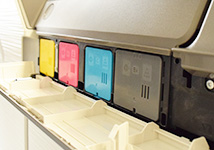
Still toner remaining
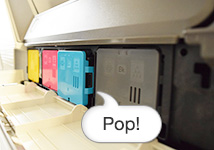
When toner runs out
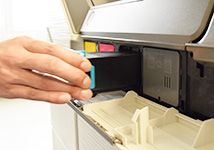
Remove the cartridge
Wow! Now users know when toner has run out—and replacement is easy! This function means customers won't waste any toner. But isn't it a problem if you have to replace the cartridge in the middle of a big copy or print job?
Okuda:No worries. There is a certain amount of toner inside the MFP itself, so copying and printing can continue uninterrupted while you are replacing the cartridge.
So you designed these MFPs to be easy to use and to be green, since no toner is being wasted.
Making MFPs Quieter
Takesue:Another member of the development team worked hard to make these new MFPs quiet. Let's hear what he has to say.
Kanemitsu (noise-reduction technology):We wanted our MFPs, which "sense the user," to provide people in the office with a quiet and pleasant environment. To achieve this, we needed to take on the challenge of making the machines quieter. Here's a question for you. To make something quieter requires that you reduce the level of noise. But that's not all. What else do you have to do?
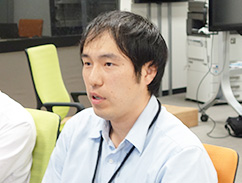
Mr. Kanemitsu, in charge of reducing noise, asked engineers in other divisions if they could change the number and type of motors in the MFP
Hmm, that's a tough one... I give up.
Kanemitsu:You also have to get rid of unpleasant sounds. Think of a piano. If you hit keys that are located close together, you don't really notice unpleasant sounds. But if you suddenly hit a high key, it sounds loud, right?
Yes, I see. High-pitched noises sound louder. It's like fingernails on the blackboard. Just thinking about it gives me goose bumps!
Kanemitsu:Hertz (Hz) is a unit used when measuring how high or low a sound is. Sounds in the 2,000–4,000 Hz range are irritating to humans. MFPs have many moving parts and therefore emit many sounds. We looked for high sounds that differ from their surroundings and worked with people in a number of other Sharp divisions to successfully reduce by 43% the sounds generated by moving parts.
Keys to Quieter Operation
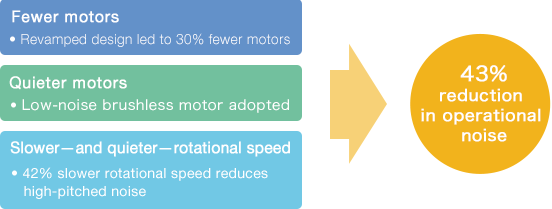
Kawakami (motion sensor control circuits):While the volume of sounds is important, also crucial is their timing in relation to other sounds. By having different parts of the MFP start at different times so that their starting sounds don't overlap, the MFP's sounds are less bothersome.
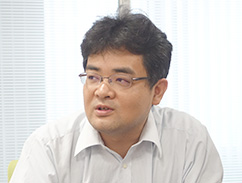
Mr. Kawakami was in charge of developing the circuits that control functions such as the motion sensor
Now that you mention it, many small sounds occurring together add up to a big sound.
Kawakami:In order to alter how and when each part of the MFP started up, we had to change things like the circuit board's connection method and the power supply system, as well as totally redesign the software that controls these. We succeeded because the hardware and software engineers all worked together to solve the various problems.
Yamaneki (software development):You could say that the motion sensor also played a role in reducing noise by sensing when a user approaches and only lighting up the control panel.
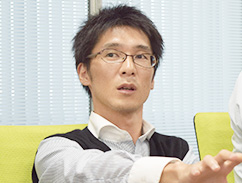
Mr. Yamaneki was in charge of software that controls things like the motion sensor module and the MFP's control panel


